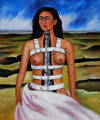Through Her Portraits - Frida Kahlo
Famous for her self-portraits, Mexican painter Frida Kahlo throbbed, and left her trace in, the art world with her face, steadfast gaze and her iconic brows. It is an uncompromising, if not political, depiction of the female experience and form.

Image rights to Sotheby's
There’s more to Kahlo’s portraits than meets the eye, for it took so much for the art prodigy to climb to her artistic heights. Having been exponentially amassing a worldwide cult following, her surrealist artistic tapestry was infused with a bittersweet – mostly bitter – life. Born in 1907 in Mexico, Kahlo was raised by her German father and Mexican mother in a house with two older sisters and one younger sister.
While others rejoiced in their childhood, Kahlo, nevertheless, was doomed with mishap contracting polio at the age of 6. She could but limp her way throughout her life, despite tapping into different sports like soccer, swimming and wrestling – downright unusual for a girl at that time – in hopes of quicker recovery, encouraged by her father.
Born an intellectual, Kahlo enrolled in the National Preparatory School as one of the few female students in 1922. There her epiphany dinged, mingling with friends who shared similar political vales, thereafter, entailed her enlistment to the Young Communist League and the Mexican Communist Party. She not only did bloom in her intellectual vision but also romantically. It started as she met Rivera who was working on a mural for the school’s auditorium.

Image rights to Banco de México Diego Rivera & Frida Kahlo Museums Trust. Av.
"I paint self-portraits because I am so often alone, because I am the person I know best."
As much as Kahlo’s paintings are a blessing, her life was awash with a series of unfortunate, almost curse-like, events; constantly wavering, paved with ups and downs and further downs – 1925 being the cataclysm. On a September afternoon that year, she travelled together on a bus with her lover, Alejandro Gómez Arias, yet things turned the other way around when the bus collided with a streetcar. Severely injured and in pain, a steel handrail impaled Kahlo through the hip, resulting in fractures in her spine and pelvis.
Grappling with excruciating ache (physically and mentally), Kahlo stayed and underwent surgeries before returning home for further recuperation. It was during her recovery that she found solace in canvas and paint brushes, finishing her first self-portrait the following year.
Kahlo and Diego Rivera had a rendezvous in 1928, wherein Rivera encouraged and evaluated her artwork. Soon the two fell in love and got married the next year, albeit the objection of Kahlo’s parents. The couple moved to the United States for Rivera’s art shows while Kahlo continued exploring her artistic vision in surrealism. In one of her paintings Henry Ford Hospital, the artist lied naked on a hospital bed, surrounded by a floating fetus, flower and a snail which are all connected by veins. It was a visceral depiction of not only her body pain but also her second miscarriage – alas, another mishap in her life. Heartbroken and devastated, Kahlo always had a yearning for motherhood, but was never a reality due to her injuries.
"They thought I was a Surrealist, but I wasn't. I never painted dreams. I painted my own reality."

The long-held body pain, however, didn’t cease the political flames in Kahlo’s mind. She attempted including Vladimir Lenin, a communist leader, in Rivera’s painting commissioned by Nelson Rockefeller. Rivera’s work was therefore halted for this very reason and the couple moved back to Mexico since the incident.
Untangling the marriage of the two is almost impossible: the push and pull, the infidelities, and the betrayals. These episodes led to their divorce in 1939, but they remarried the year after, continuing the largely separated lives and, of course, the profundity of affairs. Meanwhile, Kahlo stepped closer and closer to fame with her artworks, having various exhibitions here and there that caught the eyes of many.
Chronic pain percolated Kahlo’s life, as unfolded in her portrait The Broken Column that sees herself naked in a surgical brace, while nails penetrated throughout her body. Telegraphing her pain in the most brutal possible, Kahlo, in fact, had several surgeries that time and had to wear special corsets in order to protect her spine. The pain was by no means alleviated, rather, it exacerbated. In 1950 she was diagnosed with gangrene in her right foot, becoming bedridden for 9 months in a hospital. Nevertheless, it didn’t hold her, or her endurance down; she kept painting, like she always did.
"At the end of the day, we can endure much more than we think we can."
Troubled by her physical state and depression, Kahlo turned to alcohol and drugs. Suicidal thoughts intercepted her mind sometimes, for frequenting hospitals made her highly vulnerable. A week after her 47th birthday, Kahlo died in La Casa Azul.
Inspired by Kahlo, FRIDA embodies the quintessential yet complex qualities in the artist herself – one that endures pain regardless of incoming hardships. The outer shell resembles her strength and perseverance in the face of her health condition, whereas the soft gathered drapes echo her yearning for romance and motherhood. The juxtaposition translates the legend’s pure consciousness that inspire generations after generations.
Recent Posts


